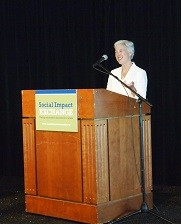
The theme of this year’s Social Impact Exchange Conference, held in June in New York City, was “Increasing Impact Through 3-Sector Collaboration – Philanthropy, Business and Government.” It is clear from this and other recent conferences that effective scaling of social innovation works best when these three sectors come together. However, a critical fourth “sector” is needed – the historic “fourth estate,” or the media. An independent press has always been democracy’s distribution channel. This is equally true in the social sector.
Throughout the conference, I was struck by the contributions the media could make to the dialogue unfolding around me. The classic role of the media is to uncover the truth, to comfort the afflicted. One way the media can do this in the social sector is to highlight challenges and obstacles to progress. I work at the Solutions Journalism Network, where our mission is to look at the whole story: rigorous and compelling reporting about responses to social problems.
The lunchtime presentations on the second day of the Conference stand out in my mind on this point. To me, “the media” was the answer to different questions that each speaker – including from the public, philanthropic, and private sectors – asked in their presentations.
Linda Gibbs, the deputy mayor for Health and Human Services in the City of New York spoke about the need for data-driven, evidence-based outcomes as key elements of accountability and success in municipal programs. She asked, “How can foundations spread the news [of successful programs that NYC has implemented] to other city mayors?” Foundations cannot be alone in spreading news of innovative programs – or the conversation will only remain amongst a limited set of people.
Darin McKeever, a deputy director at the Gates Foundation, told a deceptively nostalgic tale of “Sally,” an old-fashioned record store owner in his childhood town. He spoke about Sally’s deep musical knowledge and the insights this allowed her to bring to her work. While the Internet has radically blown open how social sector organizations share information and insights, Mr. McKeever noted that it was not a perfect solution. He relayed how online communities of funders have been created to share information about social sector innovations. But how could these online “water coolers” more effectively share their collective wisdom? McKeever’saddress outlined some of the mechanisms for enabling social sector experts to spread their knowledge. I believe the media should be a part of this dialogue, too.
Sonal Shah, a development economist and senior fellow at the Case Foundation, was the most pointed in revealing the gap between the three sectors. She relayed an anecdote from a recent dinner she attended with a range of corporate executives. She was surprised to hear many of them say they had never heard of social impact investing or social impact bonds. These executives said they felt out of touch with key developments in social entrepreneurship. Ms. Shah asked the luncheon conference group, “What can we do to address this [knowledge] gap?”
(In that particular case, our co-founder Tina Rosenberg recently wrote a Fixes column on social impact bonds.)
Each of the three key sectors – public, private and philanthropic – need access to equal information to create a balanced system that can move successful innovations forward. A powerful synergy can be created when intelligent and credible journalism – the “fourth sector” – reports on proven innovation in the field of social entrepreneurship.
Julia Power Burns is the Chief Financial Officer of the Solutions Journalism Network, Inc.(SJN). SJN’s mission is to legitimize and spread the practice of solutions journalism: rigorous and compelling reporting about responses to social problems.